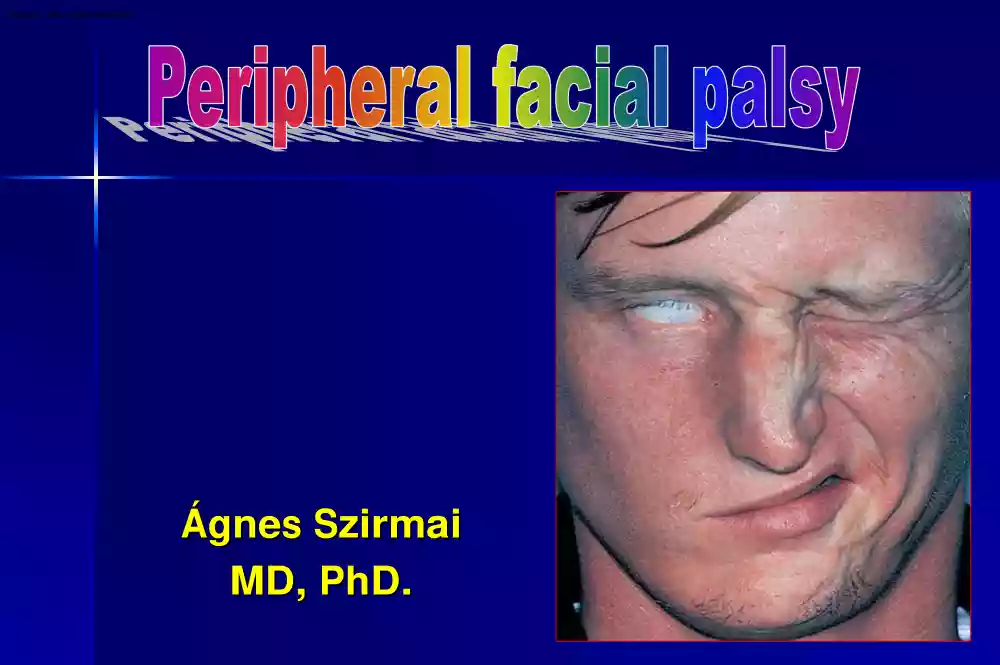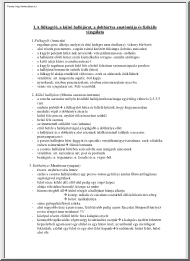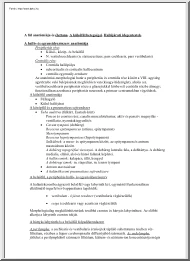Datasheet
Year, pagecount:2009, 29 page(s)
Language:English
Downloads:3
Uploaded:December 03, 2018
Size:2 MB
Institution:
-
Comments:
Attachment:-
Download in PDF:Please log in!
Comments
No comments yet. You can be the first!Content extract
Source: http://www.doksinet Ágnes Szirmai MD, PhD. Source: http://www.doksinet Supranuclear pathways Pontine nuclei Intracranial part Extracranial, intratemporal part (Fallopian canal) Extratemporal part Source: http://www.doksinet Distorting, visible disease Severe inconvenience in everyday life (eating, socialisation, mood) Many causes –severe diseases Source: http://www.doksinet No wrinkles on face, on forehead No eye-closure, Bell’s phenomenon No movements on face Nasolabial assymmetry Lacrimation or dry eye Hyperacusia, Tasting disorder Source: http://www.doksinet Types of palsy: Central, supranuclearperiorbital and temporal muscles are working Peripheral, nuclear- all branches of nerve Severity of palsy: Incomplete – mild movements Complete palsy- no movement at all Source: http://www.doksinet (based on electrodiagnostic tests) Neurapraxia: no movement, but electric function is measurable Axonotmesis:
no movement, electric reflectivity is absent, perineurium is normalspontaneous regeneration is possible Neurotmesis: no movement, electric reflectivity is absent, perineurium is distroyedspontaneous regeneration is impossible (anatomical lesion) Source: http://www.doksinet Developmental disorders Traumas Infections Tumours Bell’s palsy (idiopathic) Source: http://www.doksinet Bilateral absence of facial nuclei Sleeping Crying Laughing Source: http://www.doksinet Pyramid bone fracture Transversal fracture Prompt palsy – lesion of nerve Longitudinal fracture Prompt palsy – lesion of nerve Delayed palsy- perifocal edema Other traumas: Traumas of the face Iatrogenic traumas during ear, or parotid surgery Source: http://www.doksinet Bacterial infections: Mostly complication of acute or chronic middle ear infections Lyme borreliosis: Tick’s bite in case history, erythema migrans Viral infection: Influenza, herpes
simplex, herpes zoster oticus Source: http://www.doksinet Brain stem tumours Other neurological symptoms, e.g abducent nerve palsy Pontocerebellar and intrameatal tumours Cochleovestibular symptoms Middle ear tumours Facial palsy is a late symptom Parotid gland tumour Palsy occurred only in malignant tumours Source: http://www.doksinet Source: http://www.doksinet Sudden onset, without causes Edema of nerve>compression > hypoxia > increasing edema > increasing compression in Fallopian canal >impaired function E.g local cooling Diagnostic procedure: exclusion of other diseases Prognostical prediction: after a week Source: http://www.doksinet Otoscopy Audiometry, tympanometry, stapedial reflex Imaging methods (Schüller, CT, MR) Parotid gland palpation (ultrasonography) Blood tests (diabetes!), blood pressure Topical diagnosis n. petrosus- lacrimation -Shirmer teszt n. stapedius-hyperacusis- stapedial reflex chorda
tympani –tasting disorders- gustometria Electrodiagnostic tests Source: http://www.doksinet In every palsy case: Psychical support of patients Ophthalmological control (keratitis) Covering the eye-ball, eyedrops Electrotherapy, selective stimulation of the nerve or the muscles to prevent atrophy. In the recovery stadium -active movement . Source: http://www.doksinet Medical treatment: Corticosteroids (if no contraindications) Vitamin B , antihistamins, antiviral drugs (acyclovir) Surgery: Decompression- Fallopian canal opening-if no regeneration- after 3 months After complete axonotmesis no complete recovery Source: http://www.doksinet Headache is the most common complaint. Most of the cases have common cause. Sometimes diagnosis is a long and difficult procedure. Ear-nose-throat diseases can cause headache! Source: http://www.doksinet Primary headaches Migraine, tension headache, cluster headache, chronic paroxysmal hemicrania
Secondary headaches Headaches due to neurological reasons Posttraumatic, vascular, infectious headaches, metabolic headaches Otolaryngolocical and ophthalmological headaches Neuralgias Source: http://www.doksinet Diseases of nasal and paranasal sinuses Nasopharyngeal diseases Outer and middle ear diseases Source: http://www.doksinet Localisation of pain Forehead Face Top of the head Periorbital Types of headache Pulsating Pressure, tension Source: http://www.doksinet Pain on forehead: Frontal or maxillar sinusitis, nose breathing problems (e.g septal deviation) Facial pain: maxillary sinusitis, closure of semilunar hiatus (e.g nasal polyps) Pain on the top of head: sphenoid sinusitis Periorbital pain: ethmoiditis, complications of sinusitis Source: http://www.doksinet Type of headache: tension, pressure Concomittant symptoms: nose breathing problems, mucoid discharge Drainage decreases the pain Pathomechanism of
pain: ostiomeatal unit closure Source: http://www.doksinet Mild pressure of forehead or/and face Concomittant symptoms: Nasal breathing problems Odorous discharge Nose bleeding Occlusion disorders Facial assymmetry Eye movement disorders because of eye ball displacement Source: http://www.doksinet Orbital cellulitis Orbital abscess Osteomyelitis Thrombophlebitis of cavernosal sinus Meningitis Brain-abscess Source: http://www.doksinet (adenoids, nasopharyngeal tumours) Mild pain (nuchal region and/or top of the head) Concommitant symptoms: Nasal breathing problems Conductive hearing loss Retronasal discharge Posterior nose bleeding Source: http://www.doksinet Outer ear disorders: usually earache Pressure: wax in the external meatus Pulsating pain: external otitis Neuralgiform pain: herpes zoster Middle ear diseases: usually earache Pulsating pain: acute, purulent middle ear inflammation Mild headache is
rare, usually caused by cholesteatoma Complications of middle ear inflammatory diseases Inner ear diseases: No headaches Temporomandibular joint disorders (Costen syndrome): Unilateral headache, earache, chewing problems Source: http://www.doksinet Mastoiditis Subperiosteal abscess Labyrinthitis Peripheral facial palsy Thrombosis of sigmoideal sinus Petrositis Meningitis Brain abscess Source: http://www.doksinet Evaluation of headache provoking diseases Adequate treatment of causing diseases Adaquate medication of pain Source: http://www.doksinet
no movement, electric reflectivity is absent, perineurium is normalspontaneous regeneration is possible Neurotmesis: no movement, electric reflectivity is absent, perineurium is distroyedspontaneous regeneration is impossible (anatomical lesion) Source: http://www.doksinet Developmental disorders Traumas Infections Tumours Bell’s palsy (idiopathic) Source: http://www.doksinet Bilateral absence of facial nuclei Sleeping Crying Laughing Source: http://www.doksinet Pyramid bone fracture Transversal fracture Prompt palsy – lesion of nerve Longitudinal fracture Prompt palsy – lesion of nerve Delayed palsy- perifocal edema Other traumas: Traumas of the face Iatrogenic traumas during ear, or parotid surgery Source: http://www.doksinet Bacterial infections: Mostly complication of acute or chronic middle ear infections Lyme borreliosis: Tick’s bite in case history, erythema migrans Viral infection: Influenza, herpes
simplex, herpes zoster oticus Source: http://www.doksinet Brain stem tumours Other neurological symptoms, e.g abducent nerve palsy Pontocerebellar and intrameatal tumours Cochleovestibular symptoms Middle ear tumours Facial palsy is a late symptom Parotid gland tumour Palsy occurred only in malignant tumours Source: http://www.doksinet Source: http://www.doksinet Sudden onset, without causes Edema of nerve>compression > hypoxia > increasing edema > increasing compression in Fallopian canal >impaired function E.g local cooling Diagnostic procedure: exclusion of other diseases Prognostical prediction: after a week Source: http://www.doksinet Otoscopy Audiometry, tympanometry, stapedial reflex Imaging methods (Schüller, CT, MR) Parotid gland palpation (ultrasonography) Blood tests (diabetes!), blood pressure Topical diagnosis n. petrosus- lacrimation -Shirmer teszt n. stapedius-hyperacusis- stapedial reflex chorda
tympani –tasting disorders- gustometria Electrodiagnostic tests Source: http://www.doksinet In every palsy case: Psychical support of patients Ophthalmological control (keratitis) Covering the eye-ball, eyedrops Electrotherapy, selective stimulation of the nerve or the muscles to prevent atrophy. In the recovery stadium -active movement . Source: http://www.doksinet Medical treatment: Corticosteroids (if no contraindications) Vitamin B , antihistamins, antiviral drugs (acyclovir) Surgery: Decompression- Fallopian canal opening-if no regeneration- after 3 months After complete axonotmesis no complete recovery Source: http://www.doksinet Headache is the most common complaint. Most of the cases have common cause. Sometimes diagnosis is a long and difficult procedure. Ear-nose-throat diseases can cause headache! Source: http://www.doksinet Primary headaches Migraine, tension headache, cluster headache, chronic paroxysmal hemicrania
Secondary headaches Headaches due to neurological reasons Posttraumatic, vascular, infectious headaches, metabolic headaches Otolaryngolocical and ophthalmological headaches Neuralgias Source: http://www.doksinet Diseases of nasal and paranasal sinuses Nasopharyngeal diseases Outer and middle ear diseases Source: http://www.doksinet Localisation of pain Forehead Face Top of the head Periorbital Types of headache Pulsating Pressure, tension Source: http://www.doksinet Pain on forehead: Frontal or maxillar sinusitis, nose breathing problems (e.g septal deviation) Facial pain: maxillary sinusitis, closure of semilunar hiatus (e.g nasal polyps) Pain on the top of head: sphenoid sinusitis Periorbital pain: ethmoiditis, complications of sinusitis Source: http://www.doksinet Type of headache: tension, pressure Concomittant symptoms: nose breathing problems, mucoid discharge Drainage decreases the pain Pathomechanism of
pain: ostiomeatal unit closure Source: http://www.doksinet Mild pressure of forehead or/and face Concomittant symptoms: Nasal breathing problems Odorous discharge Nose bleeding Occlusion disorders Facial assymmetry Eye movement disorders because of eye ball displacement Source: http://www.doksinet Orbital cellulitis Orbital abscess Osteomyelitis Thrombophlebitis of cavernosal sinus Meningitis Brain-abscess Source: http://www.doksinet (adenoids, nasopharyngeal tumours) Mild pain (nuchal region and/or top of the head) Concommitant symptoms: Nasal breathing problems Conductive hearing loss Retronasal discharge Posterior nose bleeding Source: http://www.doksinet Outer ear disorders: usually earache Pressure: wax in the external meatus Pulsating pain: external otitis Neuralgiform pain: herpes zoster Middle ear diseases: usually earache Pulsating pain: acute, purulent middle ear inflammation Mild headache is
rare, usually caused by cholesteatoma Complications of middle ear inflammatory diseases Inner ear diseases: No headaches Temporomandibular joint disorders (Costen syndrome): Unilateral headache, earache, chewing problems Source: http://www.doksinet Mastoiditis Subperiosteal abscess Labyrinthitis Peripheral facial palsy Thrombosis of sigmoideal sinus Petrositis Meningitis Brain abscess Source: http://www.doksinet Evaluation of headache provoking diseases Adequate treatment of causing diseases Adaquate medication of pain Source: http://www.doksinet





 Just like you draw up a plan when you’re going to war, building a house, or even going on vacation, you need to draw up a plan for your business. This tutorial will help you to clearly see where you are and make it possible to understand where you’re going.
Just like you draw up a plan when you’re going to war, building a house, or even going on vacation, you need to draw up a plan for your business. This tutorial will help you to clearly see where you are and make it possible to understand where you’re going.